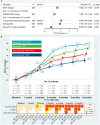The synergistic efficacy of hydroxychloroquine with methotrexate is accompanied by increased erythrocyte mean corpuscular volume
- PMID: 33944915
- PMCID: PMC8824424
- DOI: 10.1093/rheumatology/keab403
The synergistic efficacy of hydroxychloroquine with methotrexate is accompanied by increased erythrocyte mean corpuscular volume
Abstract
Objectives: To determine whether concomitant HCQ modulates the increase in erythrocyte mean corpuscular volume (MCV) caused by MTX therapy, and whether this is associated with improved clinical response in RA.
Methods: A retrospective observational analysis was conducted on two independent hospital datasets of biologic-naïve, early-RA patients who started oral MTX. Baseline characteristics, DAS28-ESR and monthly MCV after starting MTX were obtained. Conventional and machine-learning statistical approaches were applied to the discovery cohort (Cohort 1, 655 patients) and results validated using Cohort 2 (225 patients).
Results: HCQ therapy with MTX was associated with a 2-fold increase in the likelihood of response defined in this study as clinical remission or low disease activity at 6 months (P <0.001). The improved clinical outcome of combination HCQ and MTX therapy was associated with an accelerated rise in MCV from 2 months after commencing therapy. The increase in MCV at 3 months was equivalent to the contemporaneous reduction in the DAS (DAS28-ESR) in predicting clinical response at 6 months. Using latent class mixed modelling, five trajectories of MCV change over 6 months from baseline were identified. The odds ratio of response to treatment was 16.2 (95% CI 5.7, 46.4, P <0.001) in those receiving combination therapy classified within the MCV elevation >5 fl class, which contained the most patients, compared with MTX alone.
Conclusion: Our data provide mechanistic insight into the synergistic clinical benefit of concomitant HCQ with MTX, boosting the rise in MCV, which could serve as a companion biomarker of treatment response.
Keywords: HCQ; MTX; biomarker; mean corpuscular change; synergistic.
© The Author(s) 2021. Published by Oxford University Press on behalf of the British Society for Rheumatology.
Figures


Similar articles
-
Efficacy and safety of low-dose glucocorticoids combined with methotrexate and hydroxychloroquine in the treatment of early rheumatoid arthritis: A single-center, randomized, double-blind clinical trial.Medicine (Baltimore). 2020 Jul 2;99(27):e20824. doi: 10.1097/MD.0000000000020824. Medicine (Baltimore). 2020. PMID: 32629668 Free PMC article. Clinical Trial.
-
Efficacy and safety of methotrexate plus hydroxychloroquine combination therapy vs. methotrexate monotherapy in the treatment of rheumatoid arthritis: A randomized controlled clinical trial.Int J Rheum Dis. 2024 Sep;27(9):e15319. doi: 10.1111/1756-185X.15319. Int J Rheum Dis. 2024. PMID: 39223010 Clinical Trial.
-
A randomized comparative effectiveness study of oral triple therapy versus etanercept plus methotrexate in early aggressive rheumatoid arthritis: the treatment of Early Aggressive Rheumatoid Arthritis Trial.Arthritis Rheum. 2012 Sep;64(9):2824-35. doi: 10.1002/art.34498. Arthritis Rheum. 2012. PMID: 22508468 Free PMC article. Clinical Trial.
-
Real-World Outcomes Associated With Methotrexate, Sulfasalazine, and Hydroxychloroquine Triple Therapy Versus Tumor Necrosis Factor Inhibitor/Methotrexate Combination Therapy in Patients With Rheumatoid Arthritis.Arthritis Care Res (Hoboken). 2021 Aug;73(8):1114-1124. doi: 10.1002/acr.24253. Arthritis Care Res (Hoboken). 2021. PMID: 32374918
-
Meta-Regression of a Dose-Response Relationship of Methotrexate in Mono- and Combination Therapy in Disease-Modifying Antirheumatic Drug-Naive Early Rheumatoid Arthritis Patients.Arthritis Care Res (Hoboken). 2017 Oct;69(10):1473-1483. doi: 10.1002/acr.23164. Epub 2017 Aug 31. Arthritis Care Res (Hoboken). 2017. PMID: 27992656 Review.
Cited by
-
Artificial Intelligence in Rheumatoid Arthritis: Current Status and Future Perspectives: A State-of-the-Art Review.Rheumatol Ther. 2022 Oct;9(5):1249-1304. doi: 10.1007/s40744-022-00475-4. Epub 2022 Jul 18. Rheumatol Ther. 2022. PMID: 35849321 Free PMC article. Review.
-
Artificial intelligence to predict treatment response in rheumatoid arthritis and spondyloarthritis: a scoping review.Rheumatol Int. 2025 Apr 7;45(4):91. doi: 10.1007/s00296-025-05825-3. Rheumatol Int. 2025. PMID: 40192881 Free PMC article.
-
Increased erythrocyte mean corpuscular volume by methotrexate predicts clinical response in psoriatic arthritis.Rheumatology (Oxford). 2022 Aug 30;61(9):e270-e273. doi: 10.1093/rheumatology/keac276. Rheumatology (Oxford). 2022. PMID: 35532065 Free PMC article. No abstract available.
-
Machine learning-based remission prediction in rheumatoid arthritis patients treated with biologic disease-modifying anti-rheumatic drugs: findings from the Kuwait rheumatic disease registry.Front Big Data. 2024 Oct 3;7:1406365. doi: 10.3389/fdata.2024.1406365. eCollection 2024. Front Big Data. 2024. PMID: 39421133 Free PMC article.
-
An erythrocyte macrocytosis by methotrexate is associated with early initiation of biologic or targeted synthetic agents in patients with rheumatoid arthritis.J Rheum Dis. 2025 Jan 1;32(1):30-37. doi: 10.4078/jrd.2024.0073. Epub 2024 Sep 2. J Rheum Dis. 2025. PMID: 39712246 Free PMC article.
References
-
- Smolen JS, Landewé RBM, Bijlsma JWJ et al. EULAR recommendations for the management of rheumatoid arthritis with synthetic and biological disease-modifying antirheumatic drugs: 2019 update. Ann Rheum Dis 2020;79:685–99. - PubMed
-
- Singh JA, Saag KG, Bridges SL Jr et al. 2015 American College of Rheumatology guideline for the treatment of rheumatoid arthritis. Arthritis Rheumatol 2016;68:1–26. - PubMed
-
- Verschueren P, De Cock D, Corluy L et al. Methotrexate in combination with other DMARDs is not superior to methotrexate alone for remission induction with moderate-to-high-dose glucocorticoid bridging in early rheumatoid arthritis after 16 weeks of treatment: the CareRA trial. Ann Rheum Dis 2015;74:27–34. - PubMed
-
- Hazlewood GS, Barnabe C, Tomlinson G et al. Methotrexate monotherapy and methotrexate combination therapy with traditional and biologic disease modifying antirheumatic drugs for rheumatoid arthritis: abridged Cochrane systematic review and network meta-analysis. BMJ (Clin Res Ed) 2016;353:i1777. - PMC - PubMed
-
- Schapink L, van den Ende CHM, Gevers LAHA, van Ede AE, den Broeder AA. The effects of methotrexate and hydroxychloroquine combination therapy vs methotrexate monotherapy in early rheumatoid arthritis patients. Rheumatology (Oxford) 2018;58:131–4. - PubMed
Publication types
MeSH terms
Substances
Grants and funding
LinkOut - more resources
Full Text Sources
Other Literature Sources
Miscellaneous

